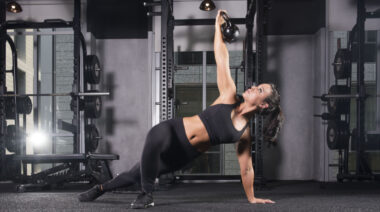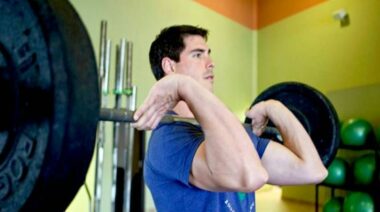With the rise of CrossFit and the mainstreaming of barbell culture, the associated surge in mobility methods has been enormous. As aches and pains and restrictions accumulate, it seems everyone’s hoping to become a little more “supple.” Foam rollers have become as ubiquitous as treadmills, and no modern gym bag is complete without a lacrosse ball. In our search for all things supple, we were told that leopards never stretch, took that as truth, and assumed that we were so fundamentally different from the rest of the animal kingdom that we had nothing more to learn from them.
I’ll admit to never having met a leopard with poor thoracic mobility from a lifetime of sitting, but I still think we can borrow more from their approach to movement than just their namesake as we try to hack our own.
Let’s start with the assertion that leopards never stretch and are somehow genetically endowed with instantly accessible stores of mobility. I may be wrong, but that cat in the photo below looks like he’s stretching to me. What’s more, I’ve seen my dog do it—I’ve even done something similar as I try to shrug off the last remnants of sleep. In humans we call this stretch-yawn syndrome (SYS), while in a broader sense it’s referred to as pandiculation.
Even the supple leopard has to take care of his body. [Photo credit: Thimindu Goonatillake CC BY-SA 2.0]
Panda-What?
Pandiculation is a very specific form of stretching, characterized by high levels of muscular tension and joint rigidity. It’s most common in animals transitioning from restful states to active ones (as in waking, or when rising from a long period hunched over your computer), and is characterized as a reflexive action. More strictly defined, pandiculation is a stretching and stiffening of the trunk and extremities, followed by a sharp drop in tension levels and a general sense of pleasure or well-being. Those big cats may extend their claws, make use of the ground, and even involve their tails, but we share the same characteristic spinal extension with nearly all vertebrates.1
From a neurological standpoint, pandiculation is interesting in how it differs from a more typical passive stretch. The active and near-maximal contraction of muscles around the joints in question requires nerve impulses to travel to and from the brain and the motor units, while a passive stretch stops at the spinal cord. This extra step may be significant in how it promotes lasting changes to the entire neuromuscular system, rather than just passive, inactive tissues. Additionally, pandiculation is thought to be regulated by the limbic system, also known as the paleomammalian brain, which is a more primitive brain system often tasked with emotional responses. You mobility geeks perked up when I said “paleo,” didn’t you? Good, because there’s more to come.
From a broader physiological perspective, pandiculation mimics some of the characteristics of a joint under load; the joint stiffness and muscular activation are similar to the isometric stabilizing contractions that occur when, say, pressing overhead. The fact that we’re not under load makes it a safer way to explore extreme ranges of motion.
Given this, is it possible that some of that supple leopard’s natural mobility is owed to this mechanism? And if so, are there methods by which we can adopt the same approach, hack our own adaptive response mechanisms, and add something to our movement toolboxes?
PNF and the GTO
In an attempt to keep using big words, let’s examine proprioceptive neuromuscular facilitation (PNF). PNF is a category of stretching techniques that attempt to make use of the muscle’s proprioceptors (specifically the Golgi tendon organ or GTO) and their interplay with the nervous system.
The role of the GTO is to protect the muscle from itself; specifically, to protect it from too much tension. If you go try to deadlift a pickup truck, odds are good you’ll trigger the GTO and, while you won’t pick up a pickup, you also won’t tear a hamstring. By applying tension to a muscle (slowly, so as to avoid activating the GTO’s counterpart—the muscle spindle—and triggering a contraction) the GTO is activated and releases tension from a muscle.
One specific form of PNF stretching, called the “contract/relax” method, bears a striking resemblance to pandiculation. As the name implies, the muscle is moved into a stretched position, contracts aggressively against outside resistance, and then relaxes into a deeper stretch than before. The higher levels of muscle tension and nervous system involvement result in noticeable improvements in range of motion, and seem to echo one of nature’s strategies for movement prep. What’s more, by limiting the amount of time spent in a stretched position, subsequent reduction in force output—critical for leopards and lifters alike—is minimal when compared to static stretching.2
Controlled Articular Rotation
Sticking with our three-letter acronyms, we come to an interesting technique from Dr. Andreo Spina. Known as controlled articular rotation (CAR), it involves what should be an increasingly familiar combination of aggressive muscular tension, full-range movement, and subsequent improvement in mobility. The science and theory behind CARs involves signaling between the joint capsule and the brain, blastic cells and cartilage formation, and a tension-transference concept known as irradiation.
The application, on the other hand, is relatively simple. The technique—focused as it is on rotation—is best-suited for our ball-and-socket hip and shoulder joints. Let’s use the shoulder as our example:
- Begin by standing tall and creating full-body tension.
- From there, reach the fingers of one hand down towards the floor. Imagine trying to scrape your nails along the surface.
- Slowly start to move your arm through the arc of a circle.
- As your arm moves forward, reach for the wall, maintaining tension through every bit of your body as you do.
- As you pass your arm overhead and behind you, flip your hand and continue until you reach the bottom position, and reverse.
That’s one. Try three per side and see how you feel. For me it’s a fantastic way to improve some pretty beaten-up shoulders and recapture a little lost mobility long enough to train overhead safely.
Progressive Muscle Relaxation
Our third example of an existing approach to movement prep builds upon the principles of pandiculation. Progressive muscle relaxation is often relegated to world of meditation, and while it has value there for recovery and regeneration, it also has value on the other side of the workout as we prepare to move with power and efficiency.
As it happens, Baechle and Earle3 were prescient in their explanation of progressive muscle relaxation:
“In essence, by going through a series of alternate muscular tensing and relaxing phases, the athletes learns to become aware of somatic tension and thereby to control it. Theoretically, the technique exerts its effect by means of a process termed reciprocal inhibition… In many cases, a positive side effect of the reduced muscle tension may be an… increased range of motion around the joint. This can be an effective self-regulation technique for some athletes before practice or competition.”
Hardwired Patterns
At this point, the link seems fairly robust between the leopard’s reflexive mechanism and our own more contrived systems for creating aggressive stiffness and subsequent improved movement function. What’s more, we have our own natural mechanism for mobility; the SYS is characteristic of the transition from restful states to active ones, and is even thought to help shift the central nervous system from sleep to wakefulness.4
We may have lost some connection to our more animal-selves and some mobility along with it, but we’re still hardwired with primal preparatory patterns designed to facilitate movement. This instinct is so vital to our survival it’s been linked through eons of evolution to the same primitive drive and reward systems as those for food, sex, and defecation. Pandiculation is a function of something known as homeostatic drive, and when we do it, we feel the same general sense of satisfaction we get from any of those other primal urges.5 Don’t believe me? Try interrupting somebody’s yawn and see how annoyed they get with you. Remember, pandiculation is governed by the limbic system, literally our emotional nerve center; of course it feels good to do.
Maybe He Wasn’t Just Stretching
If we revisit the much-lauded leopard from before and consider his mobility routine, maybe he’s doing both more and less than we thought. As we’ve seen, “stretching” may not be the best way to describe such an important and universal process. And anyone who’s ever tried a few reps of CARs has experienced just how fatiguing they can be.
Instead, pandiculation represents an evolutionary hybrid that taps us into some of the body’s most powerful adaptive mechanisms for opening up movement, initiating new cartilage formation, and transforming not only the body’s hardware (myofascial tissues) but also its operating system and associated software (the CNS) into a more malleable, mobile system.
I’m not likely to surrender my lacrosse ball, foam roller, voodoo floss, or any of the other tools that keep me semi-limber, nor do I think you should. What I would advocate is a more inclusive, less dismissive approach to self-maintenance; after all, even the supple leopard has to take care of his body.
What happens in your head as you learn a new thing?
The Psychology of Skill Development
References:
1. Bertolucci, L.F., “Pandiculation: Nature’s way of maintaining the functional integrity of the myofascial system?” Journal of Bodywork and Movement Therapies (2013) 15(3): 268-280), accessed September 7, 2016. DOI: 10.1016/j.jbmt.2010.12.006.
2. Marek et al., “Acute Effect of Static and Proprioceptive Neuromuscular Facilitation Stretching on Muscle Strength and Power Output,” Journal of Athletic Training (2005) 40(2): 94-103.
3. Baechle, Thomas R., and Roger W. Earle, Essentials of Strength Training and Conditioning, (2008) 2nd ed., Champaign: Human Kinetics.
4. Walusinski, Olivier, “Yawning: unsuspected avenue for a better understanding arousal and interception,” Medical Hypotheses (2006) 67(1): 6-14, accessed September 7, 2016. DOI:10.1016/j.mehy.2006.01.020.
5. Fraser, A.F., “Pandiculation: the comparative phenomenon of systematic stretching,” Applied Animal Behavior Science (1989) 23(3) 263-268, accessed September 2, 2016. DOI: 10.1016/0168-1591(89)90117-2.






